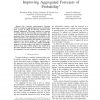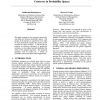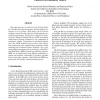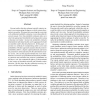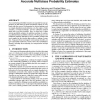CISS
2011
IEEE
13 years 6 months ago
2011
IEEE
—The Coherent Approximation Principle (CAP) is a method for aggregating forecasts of probability from a group of judges by enforcing coherence with minimal adjustment. This paper...
JMLR
2006
14 years 2 months ago
2006
The Bradley-Terry model for obtaining individual skill from paired comparisons has been popular in many areas. In machine learning, this model is related to multi-class probabilit...
NIPS
2001
14 years 4 months ago
2001
This paper presents a method for obtaining class membership probability estimates for multiclass classification problems by coupling the probability estimates produced by binary c...
GECCO
2000
Springer
14 years 6 months ago
2000
Springer
This paper proposes a new crossover operator for searching over discrete probability spaces. The design of the operator is considered in the light of recent theoretical insights i...
DEXAW
1999
IEEE
14 years 7 months ago
1999
IEEE
This paper presents two metrics for the Nearest Neighbor Classifier that share the property of being adapted, i.e. learned, on a set of data. Both metrics can be used for similari...
ECML
2003
Springer
14 years 8 months ago
2003
Springer
Abstract. In this work we investigate several issues in order to improve the performance of probabilistic estimation trees (PETs). First, we derive a new probability smoothing that...
ECML
2004
Springer
14 years 8 months ago
2004
Springer
It has been observed that traditional decision trees produce poor probability estimates. In many applications, however, a probability estimation tree (PET) with accurate probabilit...
ICDM
2006
IEEE
14 years 8 months ago
2006
IEEE
Current outlier detection schemes typically output a numeric score representing the degree to which a given observation is an outlier. We argue that converting the scores into wel...
IPPS
2007
IEEE
14 years 9 months ago
2007
IEEE
The problem of counting specified combinations of a given set of variables arises in many statistical and data mining applications. To solve this problem, we introduce the PDtree...
KDD
2002
ACM
15 years 3 months ago
2002
ACM
Class membership probability estimates are important for many applications of data mining in which classification outputs are combined with other sources of information for decisi...
